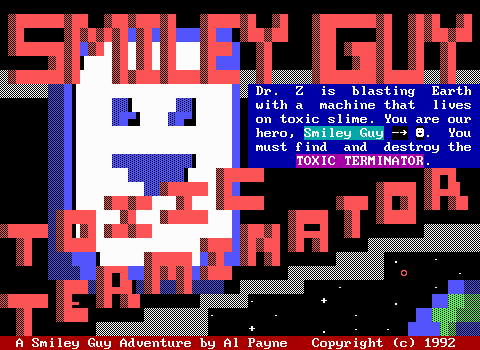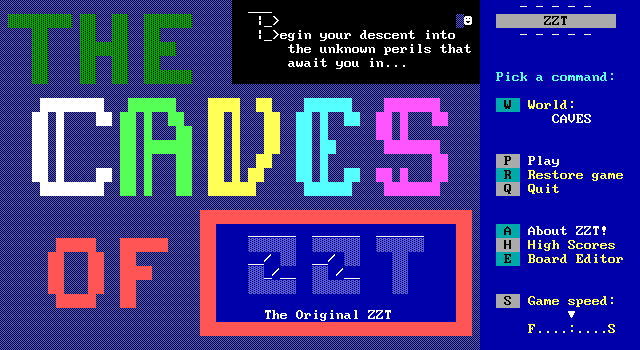
Well, it took me 21 years, but I finally played through Tim Sweeney's Caves of ZZT world. Only just now can I say that I've beaten the original four ZZT worlds. So why did it take me so long to get around to Caves?
Dark rooms! And lots of em'. Poor Caves has its reputation of being the worst of the original worlds, and now that I've played it, I have no idea if that's the case! Caves has a few very well done puzzles and action boards, but is held back by a lot of filler and backtracking. It has a lot of ups and downs, but it's worth playing for yourself if you've enjoyed the rest of the original ZZT series.

The title screen starts off nearly empty, with a little blurb and a ZZT logo in the corner. It doesn't take long for some visuals to kick in, first a background, which reveals the outline of the still invisible lettering, and then piece by piece the titles pops in. It's the most complex ZZT-OOP on a title screen for any of the original worlds.
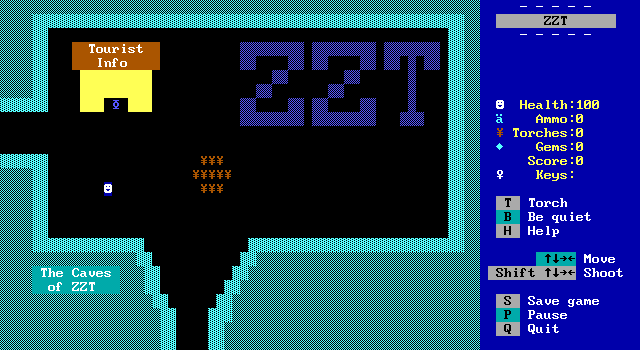
One thing Caves definitely has is branding. The opening board is quite different from the rest of the series. Town is a massive hub, with six exits; Dungeons is linear, but has a flashy opening sequence of the dungeon gates locking you inside; and City opens on a city street with two board exits and some buildings to explore. Caves feels a bit more quaint with a single scroll and some torches. The map of the caves actually makes it so you can get away with never revisiting the starting board!
Your goal is to find the four purple
keys that unlock the gates leading to the
Castle of %#^@%!!. The keys are hidden
in various locations throughout the caves.
Your adventure will lead you through
43 rooms where you must battle creatures
and solve puzzles.
To complete your quest, you will have
to make your way through the House of
Mirrors, the Key Puzzle, the Sucker and
the depths of Hell!
Good luck on your adventure. You
will certainly need it!
• • • • • • • • •
Like Dungeons, there are four purple keys to collect, with the end goal being the mysterious "Castle of %#^@%!!". Game jam idea: ZZT games that take place in the locations the original worlds end (a palace, that castle, a pub, and uh a room with a dragon using a computer).
The claim of 43 boards to explore is an inaccurate one. There are only 42 boards in the file (including the title screen), not to mention the fact that a few of them are empty and unused. However, even with the numbers being fudged a little, the fact is that Caves is actually the longest game in the series going by board count. We'll see though, that a lot of those boards, aren't exactly loaded with content.
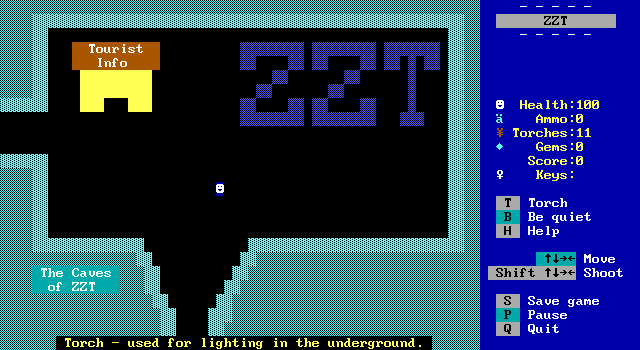
The player is given nearly a dozen torches to help start their quest. It's enough, and ample torches are provided throughout the game, but the thankful reality is that other than a handful of early boards, Caves is pretty well lit. This is a blessing really, but the opening onslaught of not very interesting dark rooms is really where the game's mediocre reception comes from.
For the sake of keeping things true to the spirit of the game, I did not cheat to turn on lights for my screenshots until I was finished with a board.
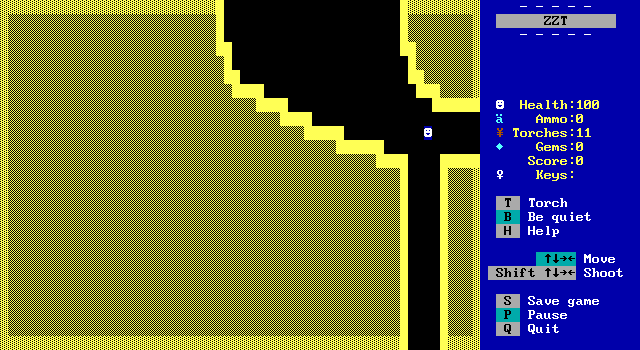
West of the opening screen is one of these boards. There are a few like it throughout the game which have nothing on them and only serve to connect disparate areas. The background just being a bunch of breakables is also a bit lower effort than the rest of the series has shown. Town's forest comes to mind with its torches as trees and dynamic looking shapes. I can even tease that this board still has yellow borders!
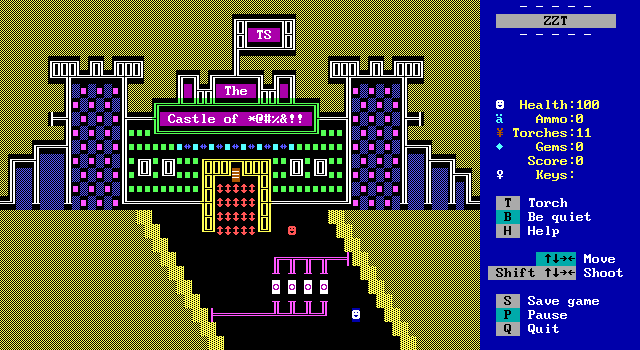
Still, it's not completely without charm. The northern path leads to the castle that the player is looking for the keys to enter, and visually this board looks fantastic. Whatever this swearing castle is for, it does have a flag in honor of Tim Sweeney. The boulder based brick pattern is good, and I'm a fan of the line wall windows as well. This is a visually distinct board and enough to be a memorable one. The only problem is this castle seems like a much more exciting place to explore than the caves themselves, and if the other games in the ZZT quadrilogy are anything to go by, there won't be much time spent inside.
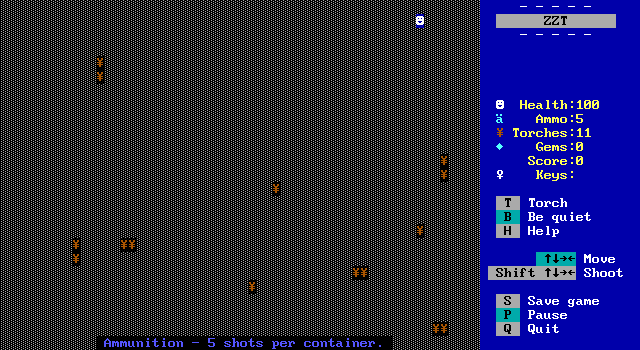
But it's this southern path that gives us the true caves experience. Dark rooms and tigers.
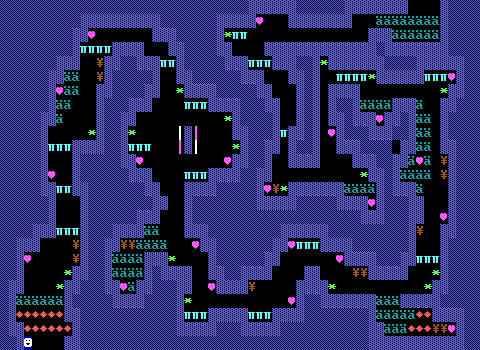
Here the player gets a start at a linear path through the darkness with a bunch of tigers, but also some ricochets. The ricochets definitely makes things more dangerous as the player can wind up shooting themselves easily enough, and definitely won't be expecting the first one. The limited range of torch light also means that the player will be firing blindly into darkness to try and get any tigers or their bullets before they get so close that there's little chance of reacting. It definitely keeps you on your toes, and if there's one thing that Caves does do right, its good use of ZZT's built-in creatures.
Another thing Caves does right is (here at least) realize that gems are a terrible terrible way to give the player health. There are plenty of purple hearts here that the player can pick up for 10 health. These all play the congratulatory music from Town's Rube board point bonus object. The music is way too long to use as a sound effect for a frequent health pickup, but at least Caves is the ZZT world that finally figures out resource management (only for these hearts to never appear again in the rest of the game, or the other two ZZT worlds which came after it).
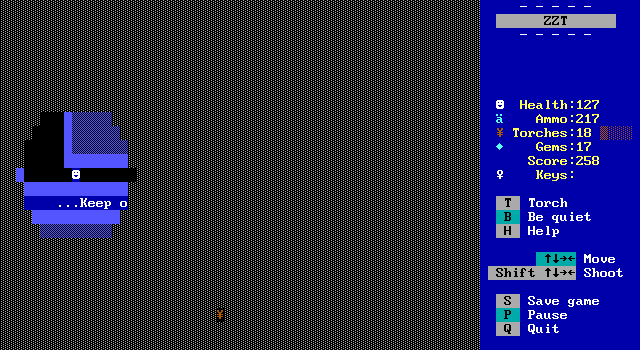
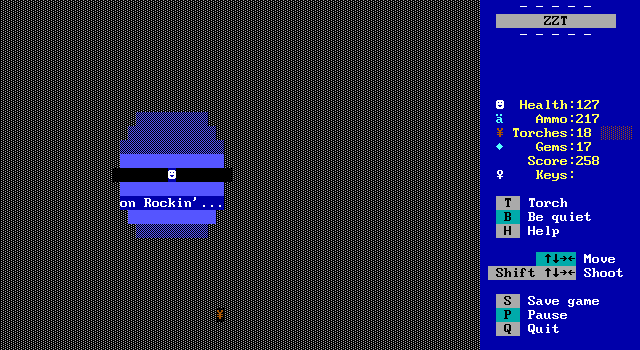
One thing that Caves likes to do is spell out messages in dark rooms for the player to slowly reveal as they run past.
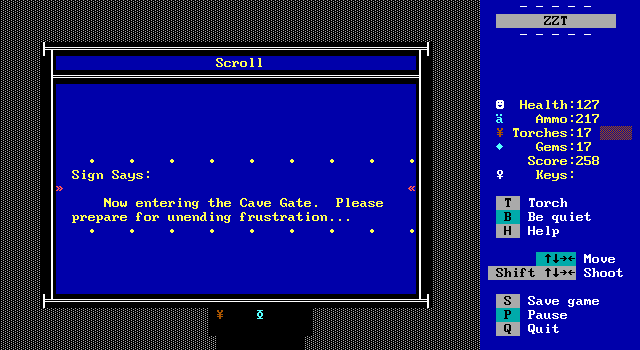
Other than these messages and a single torch there's nothing else here. It's a filler board. Get used to them.

Next though, is the game's first puzzle style board, the cave gates. There's no danger here beyond running out of torches, but that's an extremely unlikely scenario. The player simply has to navigate a simple maze with transporters and push open some gates to open up more areas to progress to. It's not particularly exciting, but it is the sort of thing that wouldn't work as well if the lights were on. Make this a regular lit board and it would probably feel tedious, but here there's enough focus required to remember which transporters haven't been explored or lead to areas currently blocked off that it at least demands some concentration.
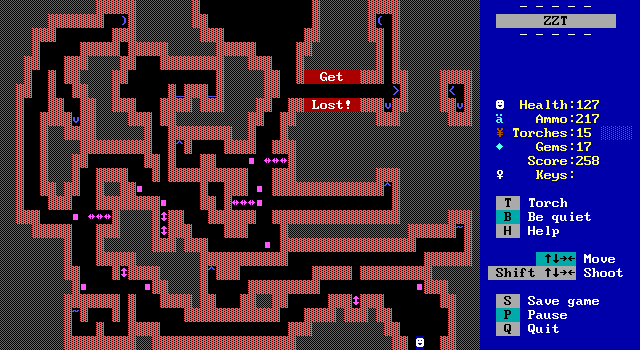
When all is said and done the board looks a bit messy with the lights on. The paths are also designed in such a way that once the gates have all been opened the player can move freely between boards without taking a single transporter. It's a long walk though, and there's an alternate exit from this branch of the caves when all is said and done with it.
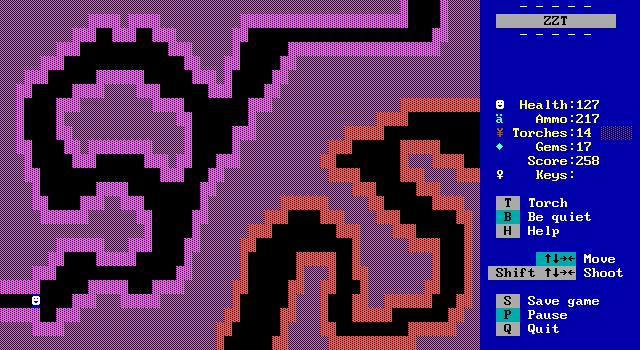
This board is dark normally, and again serves no purpose other than to reorient the player. Removing the darkness reveals that there's another path through the board later, and I personally really like these split boards. Dungeons has quite a lot of them, but in the darkness it's quite possible to never even realize you're on this board again when you make it to the red path. That this board is devoid of anything doesn't help it any. In Dungeons you could see enemies or items or something to entice you, (compare it with this board. It served as a way to tease the player, revealing content that can't yet be accessed. Here there's just nothing but twisty paths.

This branch comes to its end with a board that's naturally lit! The "House of Mirrors" is pretty straightforward for a purple key room, which in Town typically meant a puzzle board. Still, the action style does work decently enough. There are all sorts of routes through the board at first glance, but the "mirrors" are none other than invisible walls for the player to bump into.
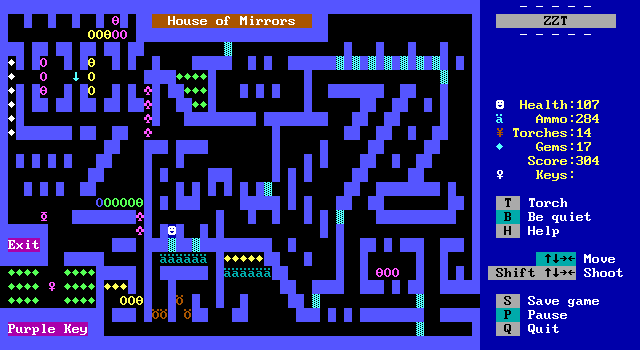
The actual route is almost completely linear. Don't misunderstand, that's not a bad thing at all, and it's a much more pleasant way of dealing with invisible walls than large mazes with no guidance that you'd see in Town's castle.
Again we see smart enemy usage however! Most of the enemies are centipedes which don't often change direction, and can even be set to only turn when they hit walls by setting their deviance parameter to zero. This lets them patrol the area without revealing in advance the actual paths through the board. Bears also combine well with invisible walls since they only move when aligned with the player to a certain degree. It's easy to create an environment where the player can't be sure if a bear is an actual threat or going to just bump into an invisible wall and suddenly stop.
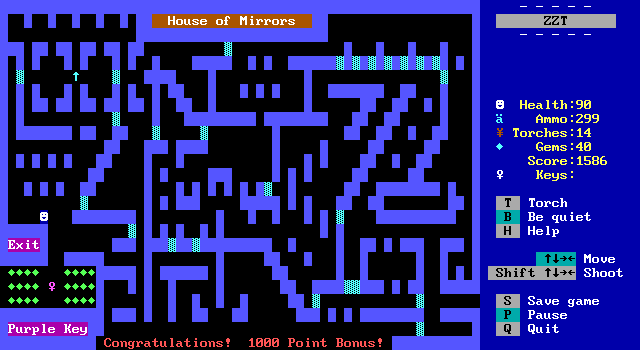
In the end, the player gets some bonus points and their first purple key. The structure of Caves makes measuring progress a lot more difficult. There are obviously four keys, but the paths to them are spread out a lot more compared to the central hubs of Town and City, and the slightly more spread out Dungeons. In Caves, things aren't as clear since the opening rooms are mostly dark and often twisty paths. You might find yourself struggling to remember where there's an unexplored path to travel in search of the other purple keys.
Although the end goal of the branch has been claimed, there's still some more boards to explore to get back to a place where another branch can be explored.
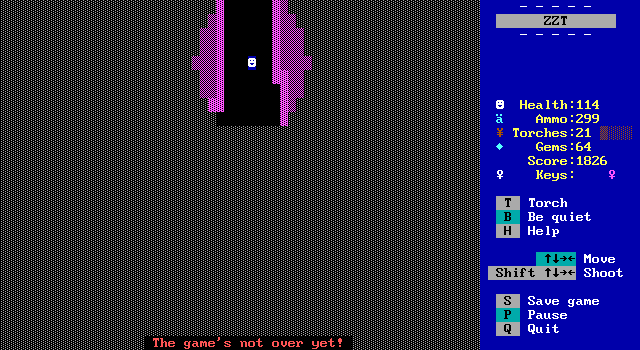
Well yeah, I mean there are three more keys.
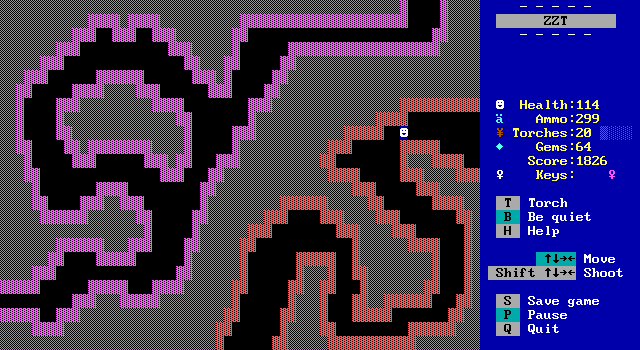
The path wraps back around and leads up through the other half of this board from earlier.
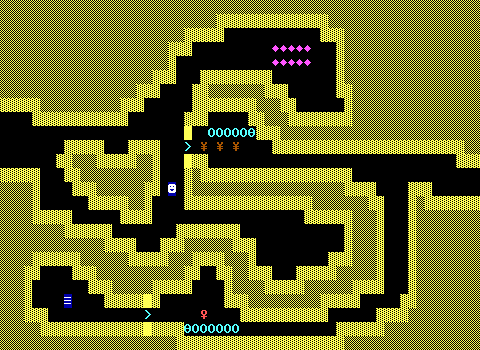
Which then continues onto a new board that mostly serves as just a way to funnel the player back to the main cave system. There are at least some items to be found and a centipede to shoot to give the room some more purpose beyond just routing. I'm not entirely sure if it's intentional (I'd guess so), but the red key here can be picked up right away and isn't necessarily a reward for the other path that leads to this room.
That's another mechanic this game has, gating off certain paths behind keys. It's not entirely unprecedented as the castle area of Town could only be accessed by collecting enough gems to pay off a bridge troll, but it's used twice in Caves with no real hint as to what's beyond the lock.

The biggest issue with the dark rooms is that it's so easy to not know where you are. I fumble around on this new board until I find an exit up top, unsure if this is a board I've been on before or not.
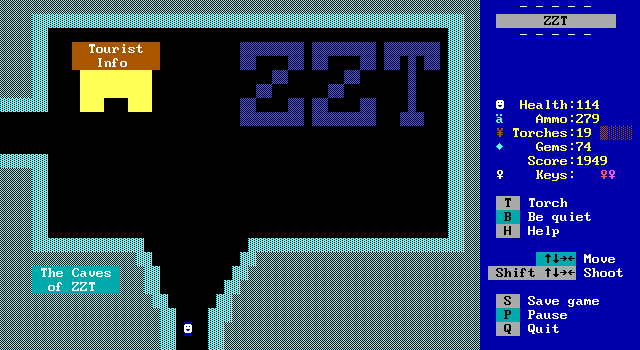
The answer is no, I had not been on that board, but my hunch that I'd be dumped somewhere close to the start of the game was correct.

A quick jaunt to the northwest and the first key is returned. Stumbling around in Caves wouldn't be that big of a deal if not for the limit of holding one key of each color. One wrong turn and the player could very easily find themselves holding a purple key and heading along a path to another that they'd be unable to obtain.

So this board is of course the other path that can be taken from the start of the game, and it's also an empty one. There's plenty of ammo available which makes it useful as a starting room just as much as the path that I took on my playthrough. Contrast again to Town where taking the east path from the start means fighting creatures in a forest using only energizers until the player can get a key and unlock a room with some ammo inside. City has a similar issue where if the player opts to go to the east they'll again find themselves in dangerous rooms without any ammo. Dungeons is smart enough to dispense some starting ammo on the very first board. Caves wins here finally, with resources loaded on the player no matter how they choose to go about things.
This board may feel like it's a proper hub, with three paths, but the one to the left is just that exit from the first key so there's nothing a player can do other than grab the red key which is needed to access the southern path. Caves just feels constricted in how the player gets through the game. At the start of the game, only one path through this board will let the player keep going and not have to turn around either to use their newly acquired key, or because they just hit a dead-end on the board itself.
It's just really easy to get a negative first impression with this game.

Anyway I of course opt to make use of that red key and head to the south where we get some more fun signage.
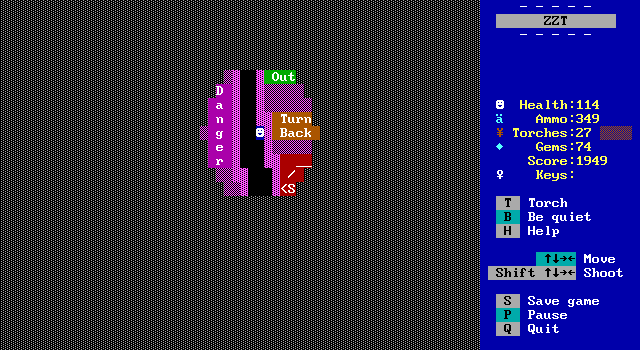
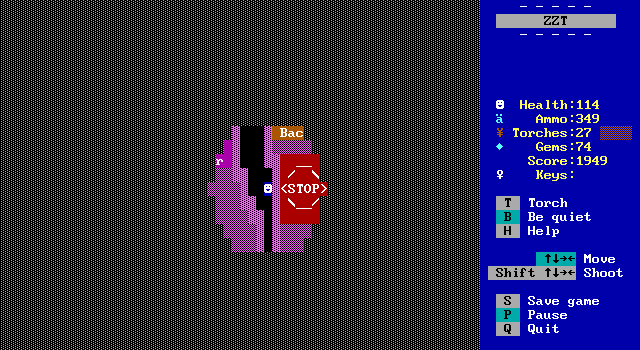
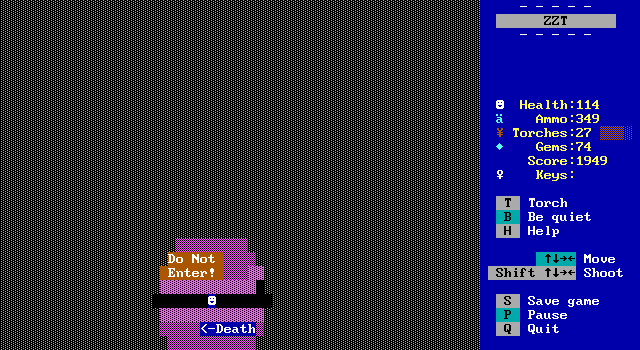
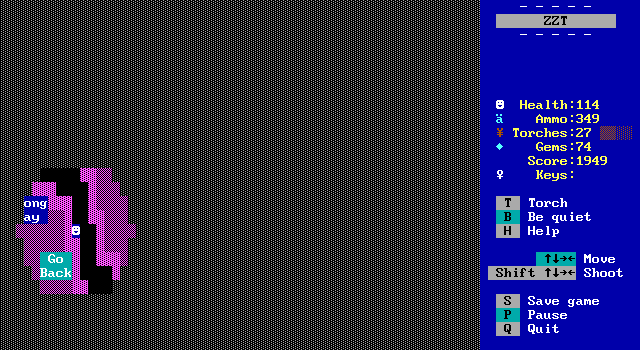
What the hell could warrant all this?

Ah. Of course.
This board is yet another empty board just to reorient the way the player is traveling, but here it's not just an empty path, but a wonderfully charming and slightly humorous board you'd expect out of an original ZZT world.
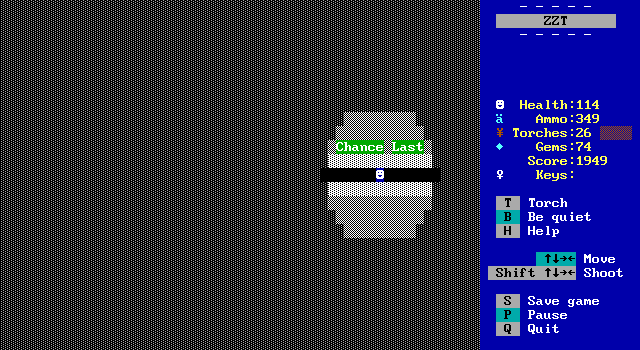
The way the player runs down this next hallway on their way to hell reveals another message running from right to left.
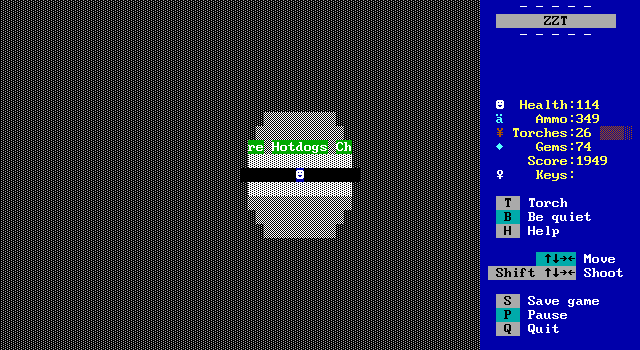
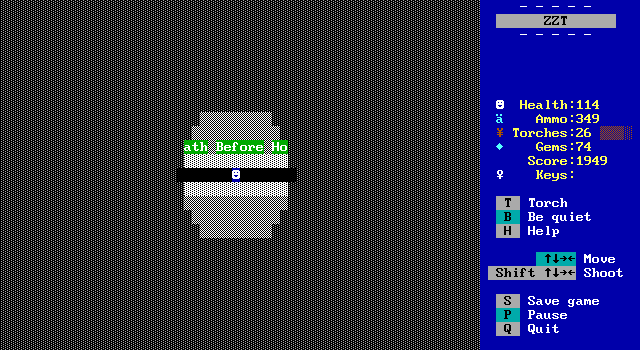

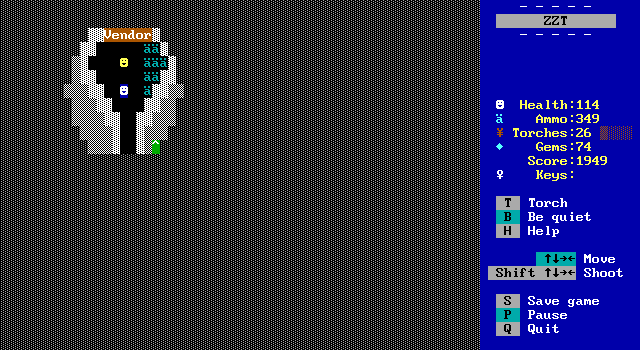
Now we've got that classic ZZT humor. Of course there's a hot dog vendor outside the gates to hell.
I love this vendor and his multiple typos. Nothing else in the series really compares to this level of warning for what's to come. Sweeney is laying it on thick and it's all for the better honestly. This board is Caves at its finest. It is entirely for flavor. The player gets nothing for eating a chili dog, but I don't care.
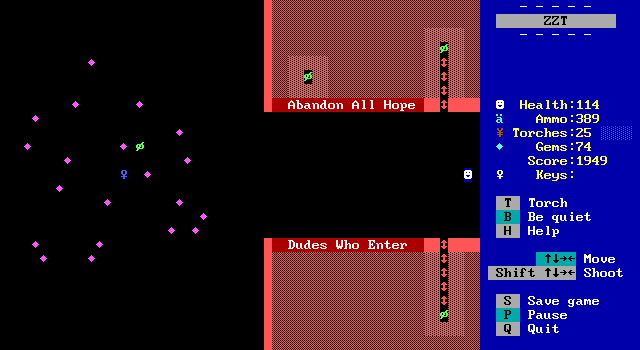
Hell breaks the rules that have been established so far. It's entirely lit (thank the lord), but more interestingly it's the first time a series of boards is intended to be one big board. Hell is a big rectangle for the player to explore and collect blue keys in.
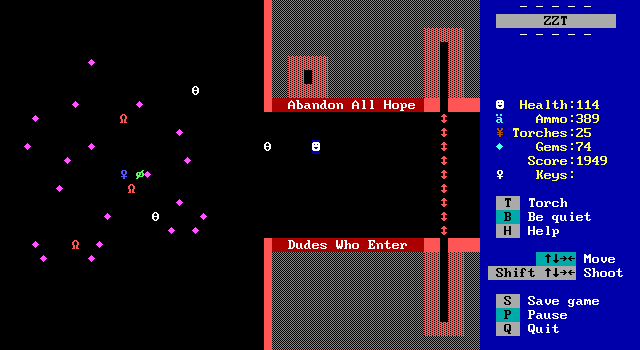
As you'd expect, the gates close behind the player once they're deep enough inside forcing the player to fight through hell or die. This first board tempts the player to go for some gems, but an indestructible green demon moves around randomly and endlessly spawns centipede heads and lions. Just grab the key and run.
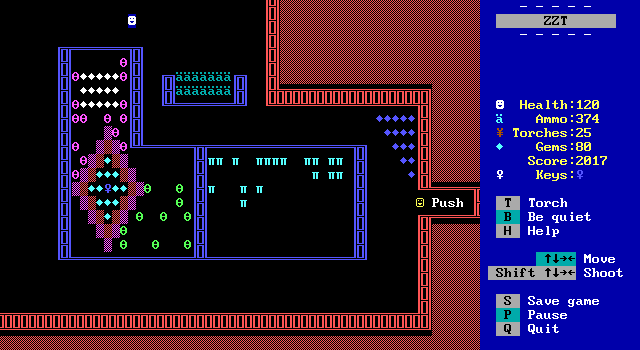
If you're familiar with the tropes of early ZZT worlds, it should be a given as soon as that first key is found just lying on the ground that hell is going to be about obtaining several of those keys to make it through. Here all the enemies as well as the key are caged, but by pushing on a smiley face all the enemies are freed as the line walls become fakes.

A good strategy is to leave behind some gems to use as a barricade. By this point you can see I'm loaded on ammunition so it's easy to stay pressed to the wall and fire away.
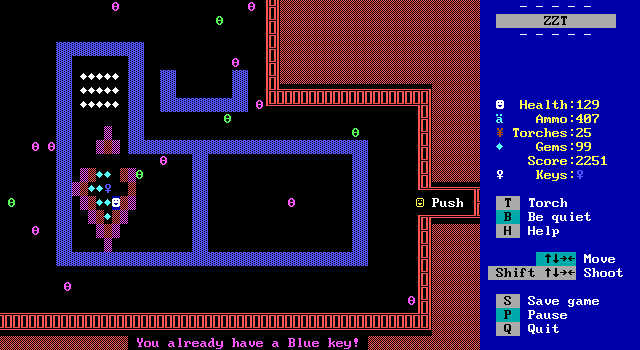
The centipedes aren't very bright so it's easy to just get the tigers and call it a day.

Continuing along, we get a freebie. It's a letdown to just hand the key out like this honestly.
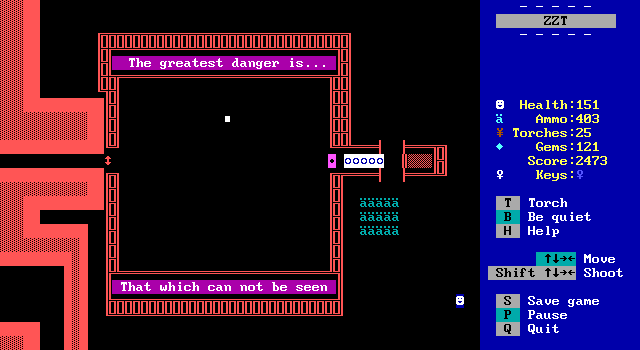
The center west board finally offers a chance to get rid of some keys. It also does a bit of excitement building with the knowledge that there's bound to be a boss fight after getting all the keys.
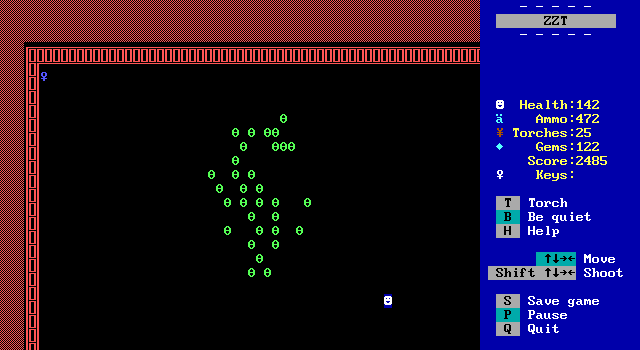
This room is just a blob of centipede heads and a key in a corner and is just a monkey's paw wish of me wanting something more than a free key like the southwest corner.
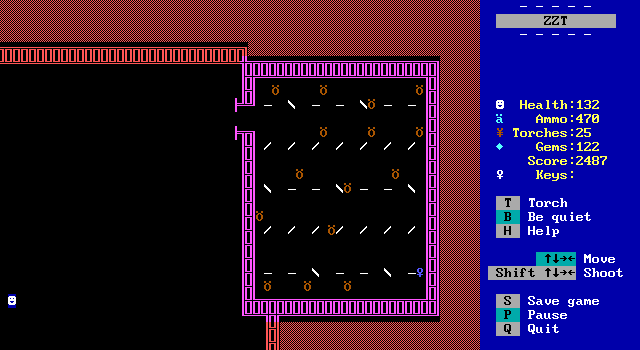
The final corner of hell is bears and conveyors. It's another action sequence that once again mixes game elements in ways that compliment each other. Bears only wanting to move straight at the player when aligned combined with them constantly being moved in circles by the conveyors creates some very unpredictable movement. This is the first time I've ever fought bears in a ZZT game where they weren't just a joke. Sweeney absolutely nails the use of ZZT's bestiary in this game.
With the final blue key collected, it's time to fight the boss of hell. There's this very flashy introduction (featuring a PC speaker rendition of the theme from the Halloween films!) before the player must face off against an invisible boss named in the code as "viper". The original worlds don't really _do_ boss fights. The castle in Town has you use bombs to defeat some dragons, and that's it.
The viper is pretty straightforward and the challenge comes from tracking them down since they're invisible the entire fight. They move perpendicular to the player a few spaces, then stop and shoot in the player's direction. This makes it pretty difficult to be shot, but also hard to hit the viper as well.
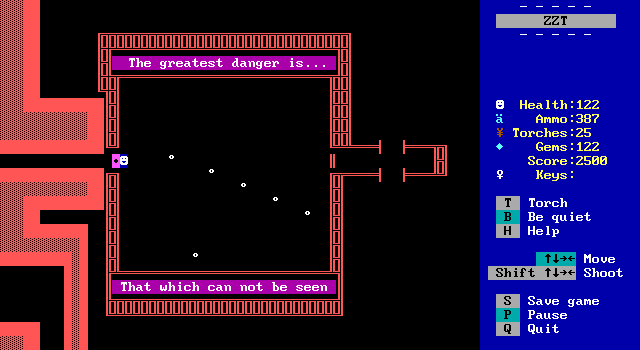
Thanks to the extremely generous amounts of ammo provided, I was able to use a strategy of spreading my fire row by row like this. It casts a wide net, but it's pretty essential to be able to hit the viper without dumb luck.
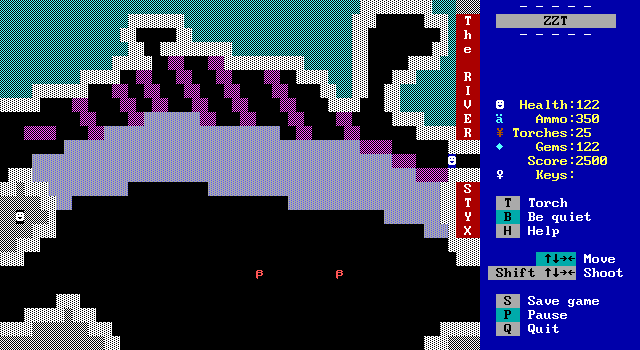
Once you get through the viper, there's still more to go with this really creative River Styx room. These two red beta objects walk across the bottom of the screen back and forth while a timer object (called "maestro"!) sends them a message every 4 seconds or so to throw a star at the player.
Stars are bad, as you'll hear time and time again, but this puzzle works really well! The player is restricted from shooting and instead needs to rely on positioning themselves in such a way that the stars will destroy themselves on breakable walls instead.

What makes this work is that there are enough breakables around for the player to keep themselves safe even if they don't immediately make any progress by doing so. You'll find yourself juggling your positioning to try and get through safely, and with some thought put into it you can make it through without taking any damage. The only real issue is the two alcoves which you would think are meant to be a place to fall back to, but actually going up there and trying to wait out any stars rather than lead them to a wall is just going to result in several more stars appearing before any disappear.
This is a very good puzzle board!

Here in the depths the player needs to move through these chambers. Each time the player touches one of the white objects (named "lucy"), the old walls disappear and a new set appears. It's in the player's best interest to defeat all the enemies before opening up the next set, but there's the danger of shooting lucy which results in a star being thrown. This helps keep the player from just standing safely on the edge of the screen and shooting into the rooms, forcing them to get inside.
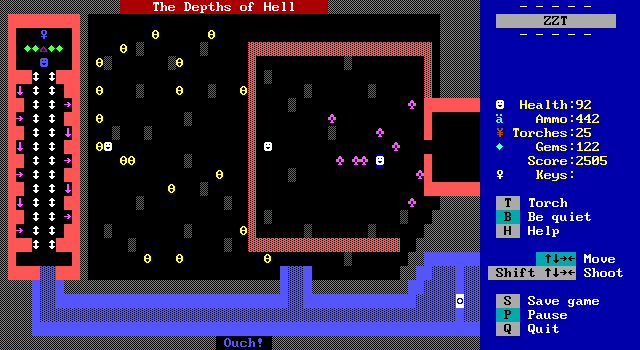


In the end, the player makes it to the blue key where another object (who I was both hoping was Satan but also was hoping wasn't Satan because why would Satan be blue) exists to erase the sliders and make the trip back seem a little more scary.
It's not scary at all of course because there's an energizer right next to the key making the spinning guns a moot point.
I do question why so many of the objects in this game use smiley faces when they aren't meant to be people for the player to interact with. They've been buttons, and maestros, and lucies, and in every case could have had a better representation.
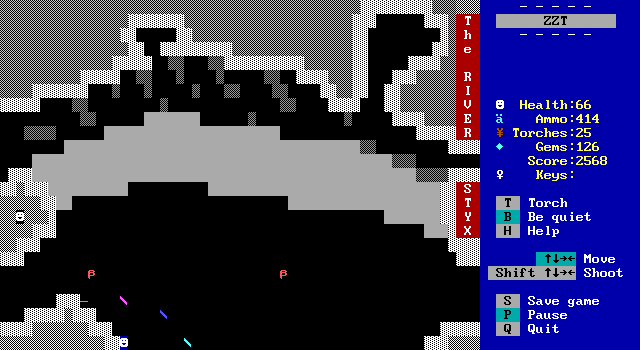
Going from the depths back to the River Styx is a lot more dangerous now without anything to keep the player safe from stars.

At least, until the player realizes they can go south and run across this board which contains some items and centipedes if they're willing to shoot out some breakable walls.
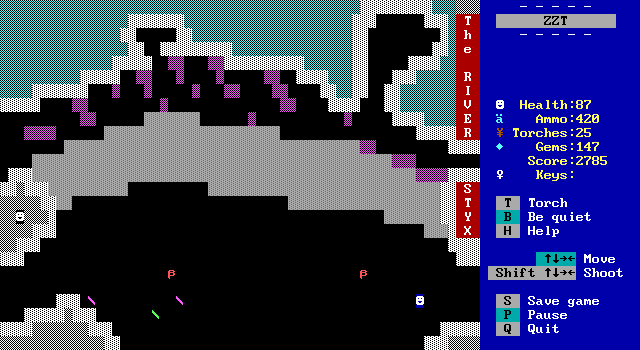
Popping up on the far right side of the screen makes it easy to escape any stars that will be on the left side of the screen letting the player make a clean get away.
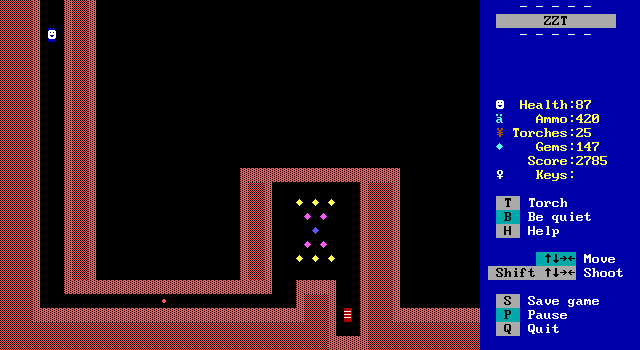
Now here we get a proper button! It winds up turning all those gems into tigers. Hell sucks.
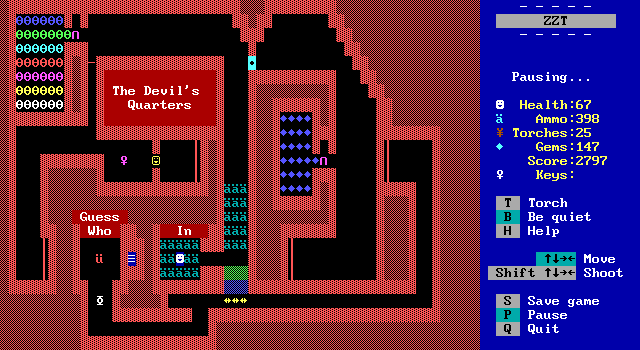
It was only a matter of time before the player got to meet the devil himself who is in possession of a purple key.
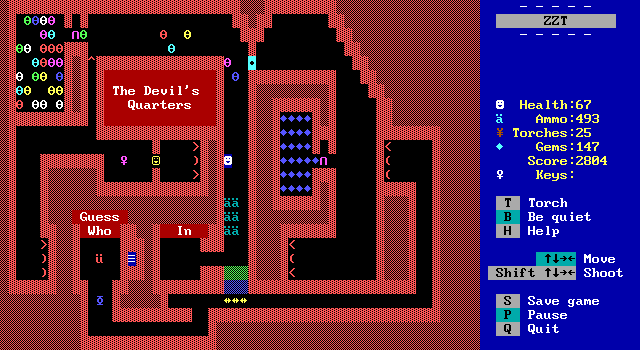
And yet again, clever enemy encounters. Here the corner area filled with centipedes has an object that acts as a gate which slowly opens and closes resulting in the enemies trickling out and preventing the player from just shooting inside.
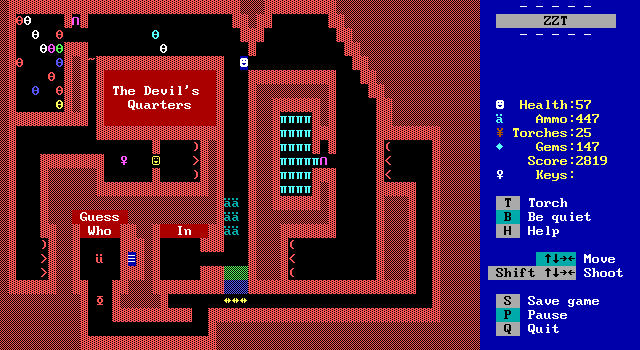
Opening the door to the next area transforms the gems into tigers, which shouldn't be all that surprising seeing as how that room also has a gate.
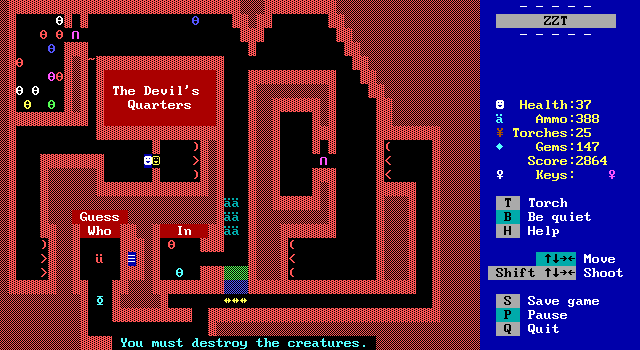
What may be less obvious is that you can't progress until you've destroyed all the creatures.
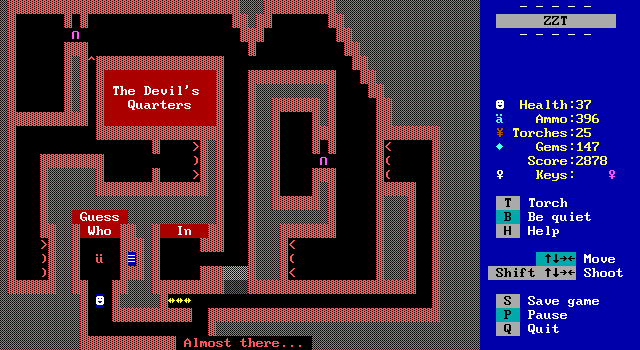
And now to meet with the devil himself!
The devil is flashy, but all talk.
Simply saying yes is all it takes to get past the devil. Saying no results in a game over.
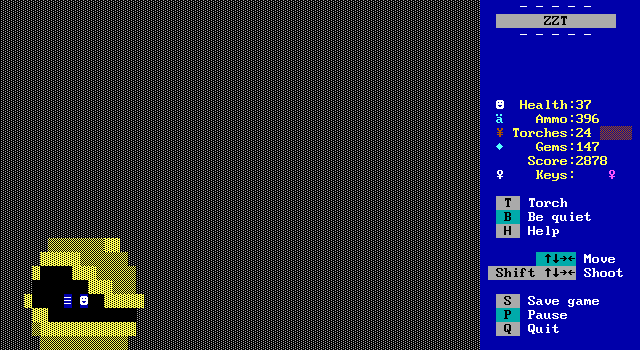
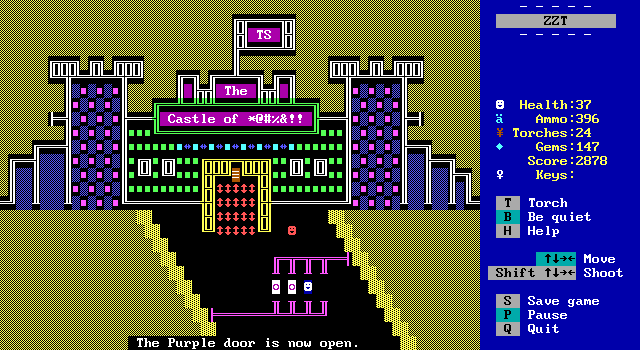
And that's purple key number two! The passage leads to the same room from earlier where the first branch ended. It's time to turn in the key and find out what's left to explore.
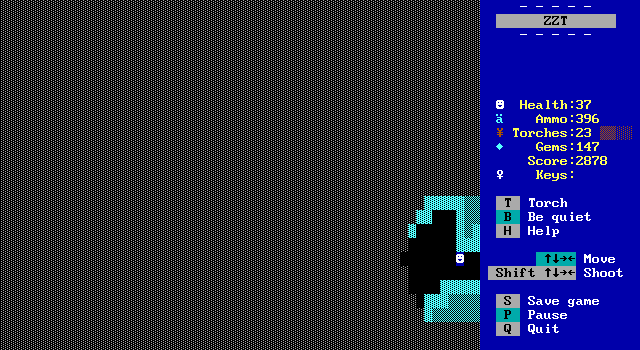
The dark boards near the start of the game make it more difficult to remember where you have and haven't been before.

South and east is where the last two keys lie. There are still two keys to go, but not a whole lot of caves left.
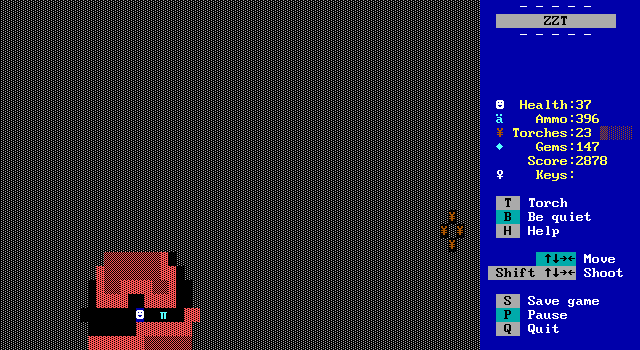
Agh. More tigers. Just like the first branch I ventured down, the player gets to fight tigers in the dark.
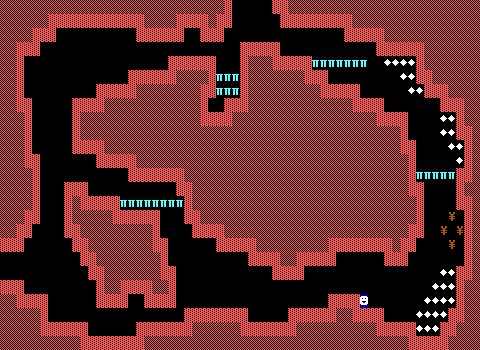
This one's a lot more simplistic than the more action packed ricochet lined tiger fight from the start. It also offers no ammo, and resorts to using gems for health again instead of the heart objects used early on. In the editor, this board comes way later than the board with hearts, and I'm surprised they aren't used elsewhere.
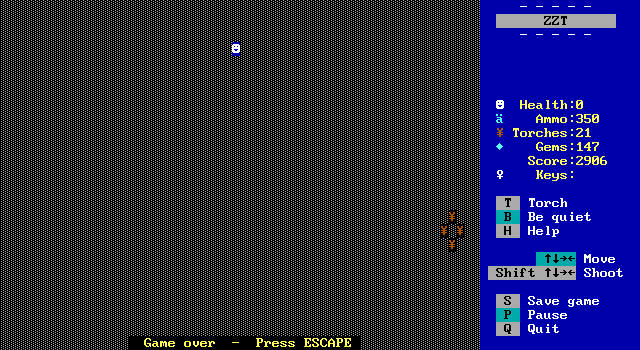
I die for the first time as well. I do want to spend a moment here to discuss this game's balance and that of the other official worlds.
Town had two major issues, unknowing soft locks like the bank, and not enough health to go around. The only way to restore life in Town, is to find gems, of which there are a limited amount of. In fact, there's a grand total of 107 meaning the player can take 20 hits safely in the entire game assuming they get every single gem.
Dungeons fares better, I'm not going to count them because on the first three playable boards in the board list, there are nearly 70 gems. The resources are much better used.
City finally introduces a shop that lets you purchase health in exchange for gems, but manages to make it useless by charging 50 gems for just 10 health! For comparison, 100 gems are needed to complete the game by bribing the mayor for an ID card. It has 211 gems so yeah. It's a good idea executed poorly.
Lastly, we have Caves which is intended to be the second game after Town. Here there's an adequate amount of gems, but also the only healing items in the entire original series! And for some reason they're just casually discarded? Town also has a shop, a concept which doesn't reappear until City. The long running tradition of weird resource allotment in ZZT worlds began right away with the original series.
Caves is a single tour guide who sells "souvenirs" of health and ammo away from being possibly the best balanced game in the series, though probably not the most fun. Having a chance to resupply between keys and not have the burden of needing gems for anything else would've been a good step in the right direction.
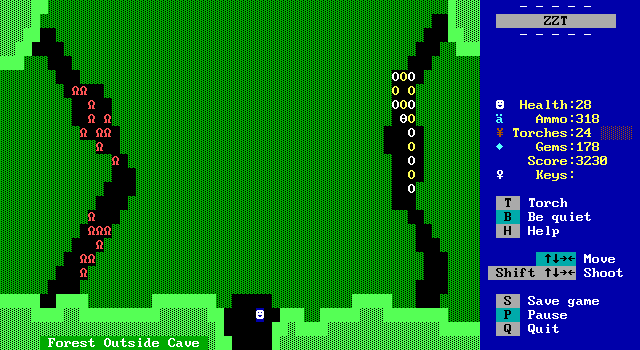
Outside! Frankly I am thankful that Caves escapes its caves and into a wider space. It's also a pretty big crossroads, which makes sense since the rest of the keys are going to be in this outer area instead. We're also done with dark rooms! In total only 11 boards in the game are dark, but the game's start was all it took to push me away from it for close to two decades.
The first steps into fresh air involve the choice of three routes, however two of them involve running into pockets of empty space with creatures to get past. Fortunately, it's very easy to time your movements and not have to worry about the centipede.
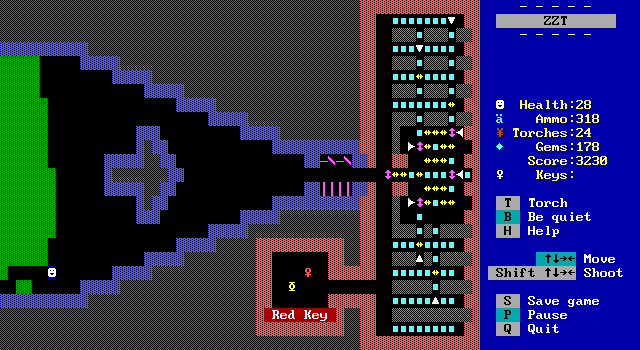
Which is good because the right side of the forest consists of a classical boulder and slider puzzle. It's also a board that disables shooting due to the use of breakable walls within the puzzle, so there's no cheap way to solve it.
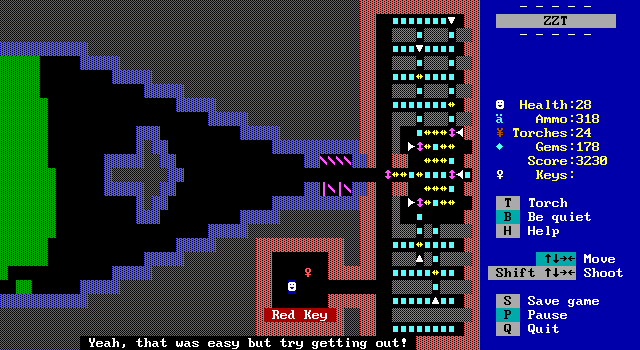
It's also a little different in that the puzzle isn't finding a way to obtain the key, but finding a way to escape after collecting the key freely. The player can walk right on in through the conveyors, but will be pushed to the right when they try to leave on their own.
The puzzle is actually very simple, as there are very few moves the player can make. The vertical slider can even be pushed aside early on since there are enough boulders the player can wedge themselves between when leaving.
This is the second red key the player can get, with the first being outside the exits from the western branches. I do like that some areas are gated, but in such a way that the game is still non-linear. You can go straight to hell... with that red key in the caves, or use it later on in the forest, and use the one in the forest to access hell instead.
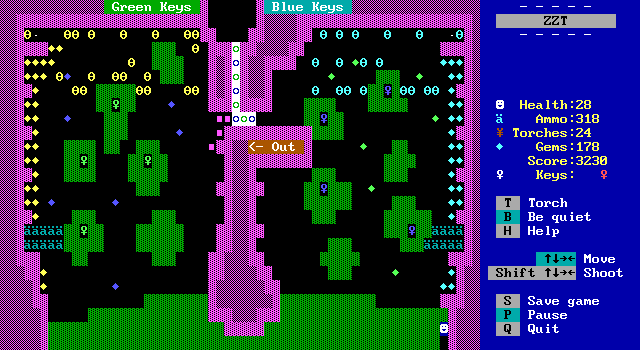
To the north is an action board reminiscent of the sequel game, Dungeons' whirlpool board. Here the player needs to collect eight keys to access the exit while dealing with infinitely spawning enemies.
This board is very well done, and possibly my favorite in the game. The monsters are abound, but the duplicators run slowly enough that things won't get too overwhelming. There's a good amount of health given via all the gems, cover provided by the forest tiles, and even a shortcut between the two halves after opening the first three doors. The whole reason this all works so well is because ammo is just not an issue by this point. Unfortunately, it would be possible for this to be the fifth board the player sees, and the ammo would be a lot tighter.
But where it goes from well made to secretly brilliant is that there's a solution to this board! It might be unintentional, but a player who realizes just what they have here can make things a lot easier.
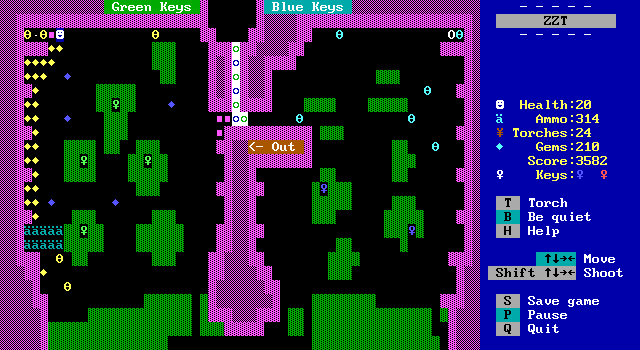
Those boulders don't just block off the shortcut. A crafty player can use them to block the duplicators and stop the flow of centipedes! As much as I love it, it's almost definitely unintentional since there are still plenty of keys to collect and hardly any centipedes remaining once the duplicators are blocked off. Still, it was a blast to play through and make that discovery.
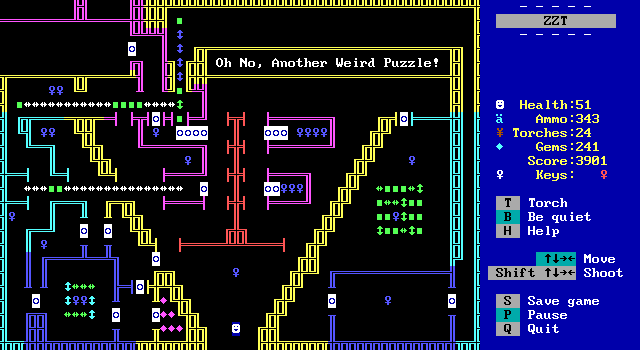
Now for a real puzzle! "Oh No, Another Weird Puzzle!" is a rather bizarre looking board, filled with a lot of blue keys and doors that the player needs to open in the correct order to proceed on through. The erratic linewall visuals really make this. It looks very intimidating and chaotic with how jarring this board looks compared to the much softer mix of solids and breakables seen throughout the caves. You get a feeling that in you're in for it once you get to this board.
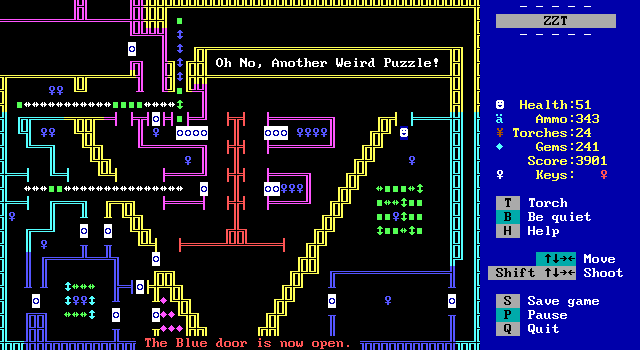
For the most part, it's not as bad as it looks. Look at the doors, and make sure you get as many or more keys from taking it. Use one key to get two, two to get three, three to get four...
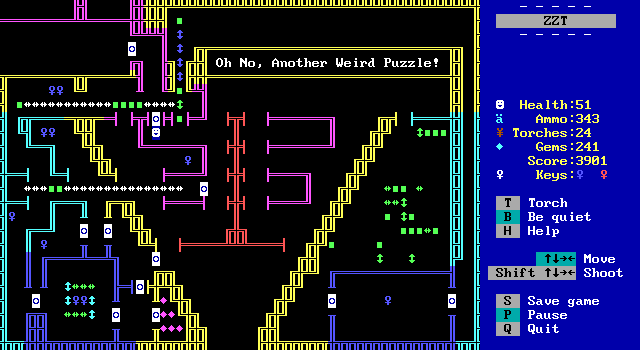
Wait. Shit. This is a dead end.
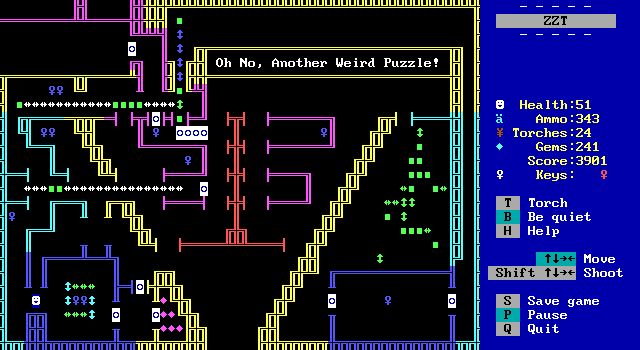
Use one key to get two, two to get three, three to get three, open three to get one, use one to get one...

Alright, still good. I have this one key, and one spare from that pocket with four. This is where it gets tricky because once the sliders get involved you're not just opening doors, but changing what areas of the board can be accessed.
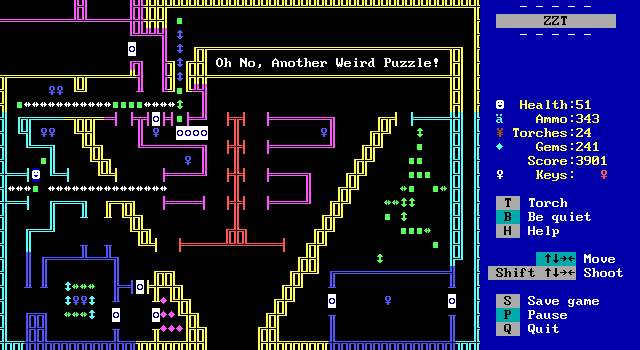
Still on track, two keys up here, and one spare still.
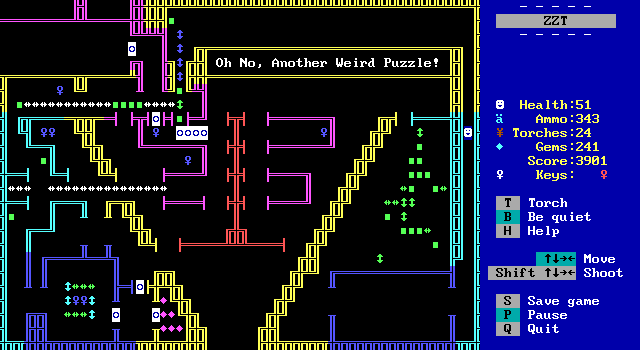
More keys get collected and doors opened and all of this is to make it so a slider can be moved up top.
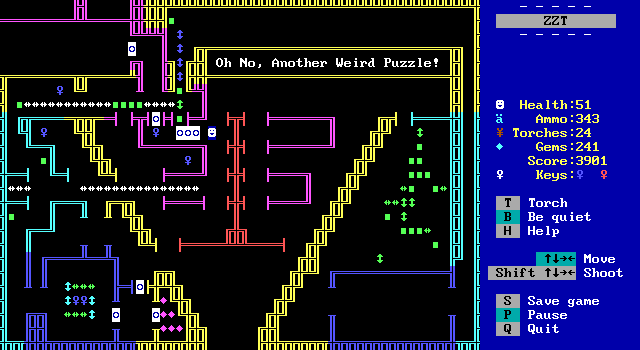
More careful pushing is required to free some keys behind the white sliders in the center left of the room.
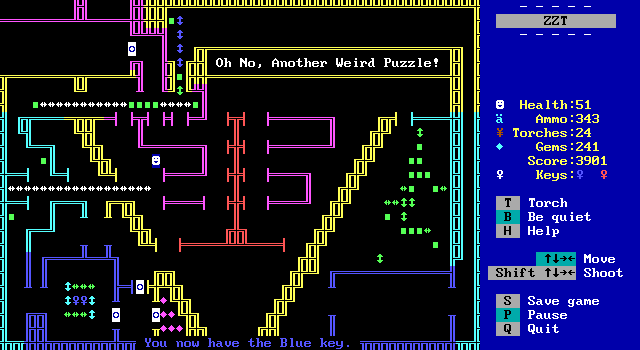
You even go as far as to cut off access to an area you were able to get to previously. It takes every key to get through. That the only red herrings are two keys that will never be accessible and some gems is laudable. This same sort of puzzle can be found in Super ZZT's Monster Zoo, but there it's a matter of finding the best combination of optimal rooms with items to open up. Here in Caves we get an excellent puzzle. It took me several tries in my playthrough to finally put it all together, but it was fun all the way through. That this board comes up immediately after the forest keys board speaks to this game's high points. These two boards in a row make for some of the best boards in the original series!

Okay, so it obviously couldn't last, but this is a perfectly reasonable board to follow up Weird Puzzle. It's simple and lets the player turn off their brain for a moment. The only concern is dodging some bullets. The linewall motif continues beyond the puzzle, and while the original ZZT worlds are pretty abstract, this path does make you ask "Where am I?"

Whenever you are, you're far far from the caves the game started in. Really this comes off as more filler, but the visuals are odd enough that it won't feel like a bad thing. These sort of environments feel more like the end of a ZZT world rather than just a single path through the world as a whole.
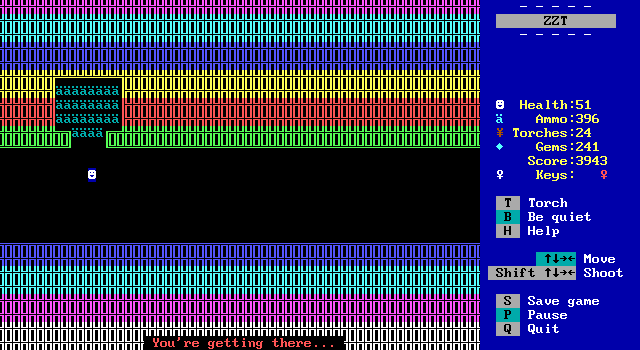
If you want to start a discussion on philosophy, Weird Puzzle and its weirder follow up boards are a good place to begin.
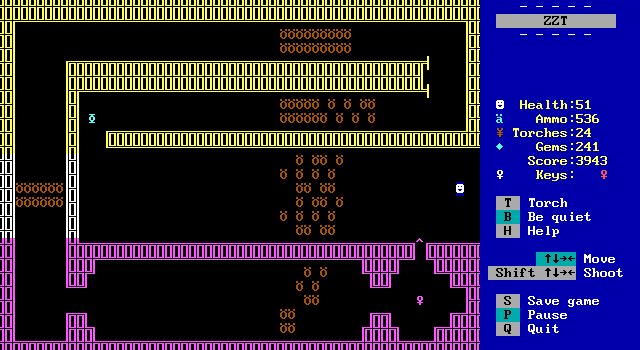
But god, it's just fluff. A hundred bears? Why?
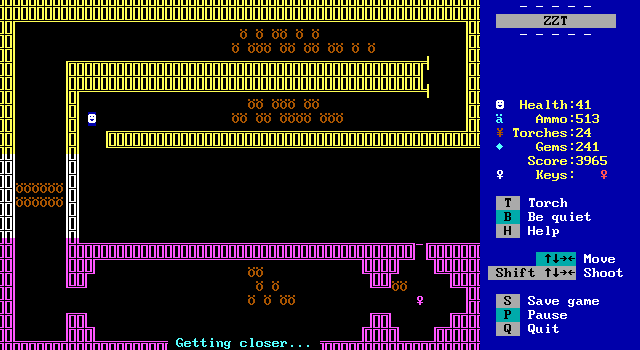
In the end, I get through over one hundred bears and only get hit once. Any other enemy would have made these boards actually engaging. For all the well thought out enemy placement earlier, this path comes to a fizzle that would've been better served by straight up handing a purple key to the player for solving Weird Puzzle.
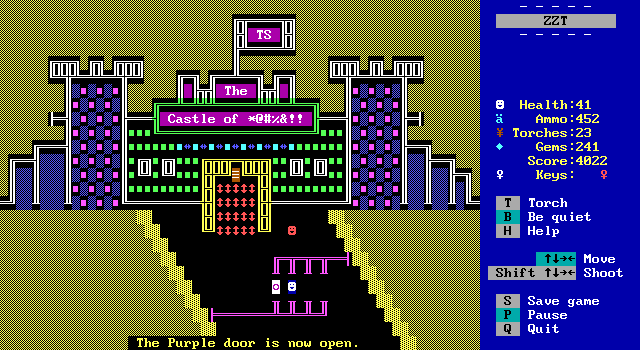
The worst part of all this is that there's a huge amount of backtracking required. Bear board, spinning gun board, weird puzzle, northern forest, forest, tiger cave, cave hub, starting board, west of starting board, and then the castle.
It's very likely that the player will face zero enemies on that 9 board walk, and since the forest is also the location of the last purple key, they'll have to do a good amount of that same walk again immediately afterwards. Perhaps a one-way(?) connection from the forest to the starting board would have been a bit nicer to a weary player?
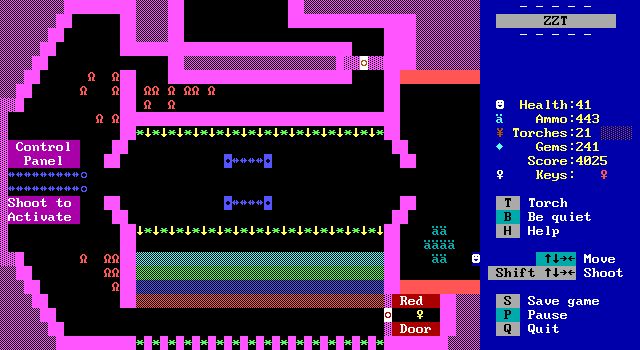
After a long walk to the forest for the final time, the last path to take is the one to the west. Like hell, it's locked behind a red door and is the other restricted path in the game.
The board itself is pretty complex compared to most so far! The center of the room is a nightmarish arrangement of spinning guns and ricochets. Bullets will fly rapidly, and the player needs to operate the controls to safely cross.

Hitting one of the buttons causes the barricades to move to the the left, while the other button moves it to the right. It's one bullet to move it all the way so the challenge is that the player has to keep moving forward with the barricades, and has to be cautious that they don't accidentally hit the other button while shooting at any lions.
It's a cool idea, but not polished as well as the northern forest. It's easy to just shoot at the lions from the far right side and get rid of most of them before making a crossing. Then there's the issue with ZZT not being capable of smooth movement when multiple objects are involved.
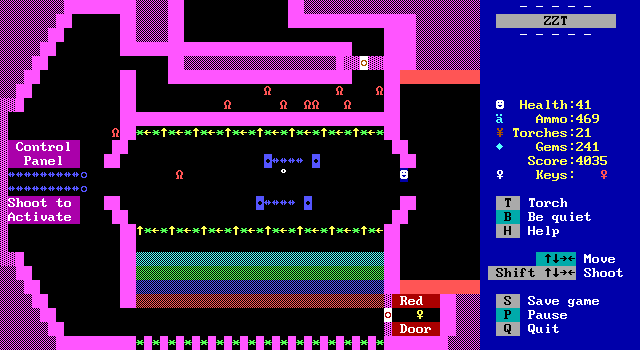
You can see it here, where the barricades have a gap between the left objects and the right ones. The barricades are long enough that the player can still keep themselves shielded, but there's a more sinister issue that can come up as well that I'll get to on the trip back.
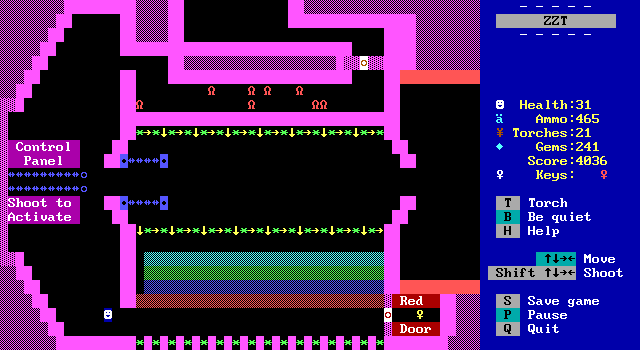
Once the player has crossed, they still need to run to the red door, using only the breakable walls to keep them safe. As long as you hold the key down you'll almost certainly be safe to make two crossings like this.

The first instance of Pac-Man in ZZT! The player can't shoot and most rely on the energizer power pellets to deal with the endlessly spawning centipedes.
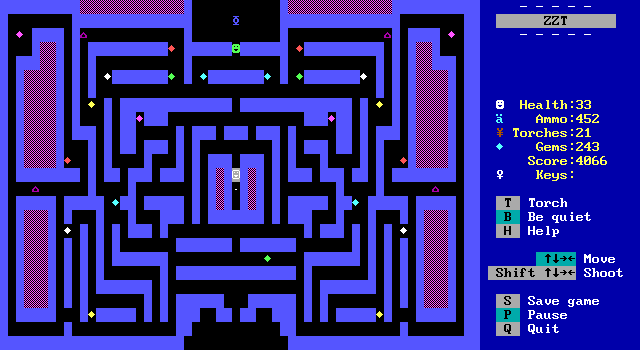
If you want to cheese it, it's incredibly easy to do so.
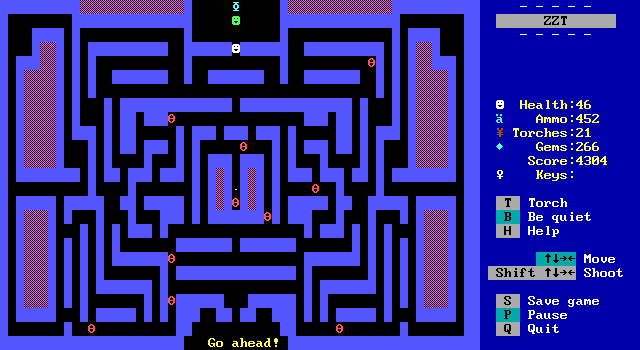
But even playing legit, it's pretty easy since there are so many paths. It's also very tedious due to how large the board is.
Also worth noting here is that ZZT version 2.0's version of Tour, which previews boards from the registered titles includes this board, but the subsequent releases replace it with the "bad part of town" from City of ZZT instead. (Probably because of the seven boards to preview, three of them came from Caves!)

It's a good thing the immature teenage boys club that was the ZZT community in the 2000s didn't see this board.
"The Incredible ZZT Sucker" is another slider puzzle, and while it's slightly more complex than the one for the red key from the eastern forest, it's still a very easy puzzle. It's very clear that the goal is to be able to push the center sliders south and release the key, which just involves supplying a handful of boulders to the main horizontal beam.
Of course, if you just rush inside the conveyors and pick up the key directly...
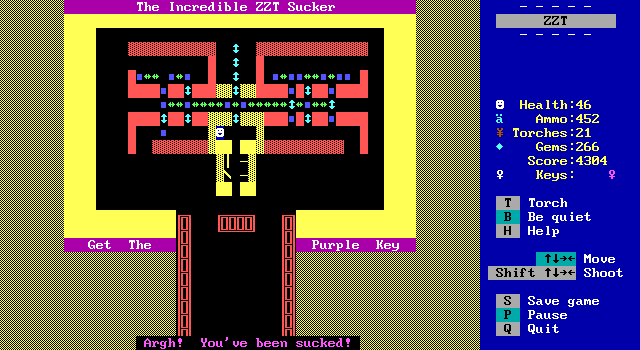
There's a theme here of having to escape conveyors to progress.
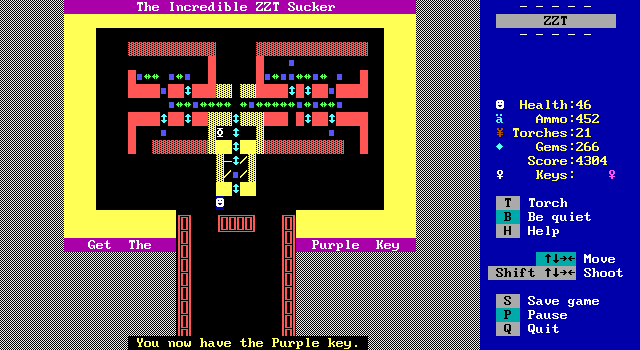
Still, it doesn't take much to solve. The slider puzzles are definitely turned down in difficulty compared to Town. The fourth and final purple key is collected. It's time to venture into the castle.
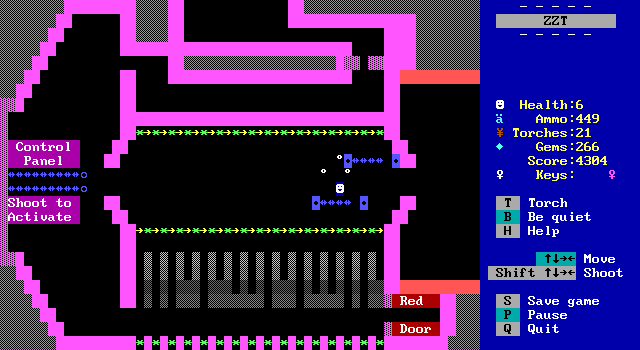
OH GOD
So yeah, there's a big problem here where since there's no real way to sync the object, all it takes a single bullet _blocking_ the barricades from moving for a cycle to cause them to drift apart from each other. This combined with the gap that forms just by trying to move two objects together can make things really fall apart quickly.
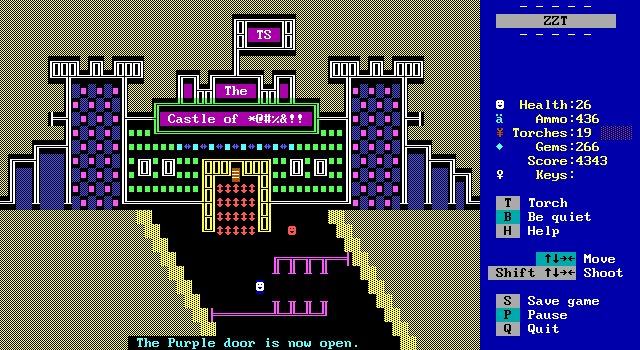
Reloading my save after getting killed by this horrible barricade accident, I was able to make it to the "Castle of *@#%&!!" and see how the game would end.
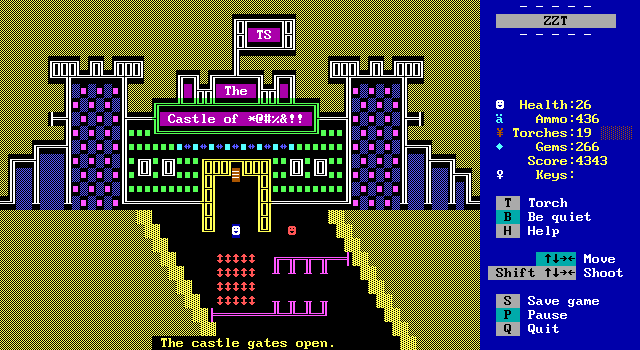
Touching the red object causes them to lower the gates and give entry. It's not nearly as flashy as entering the palace in Town.
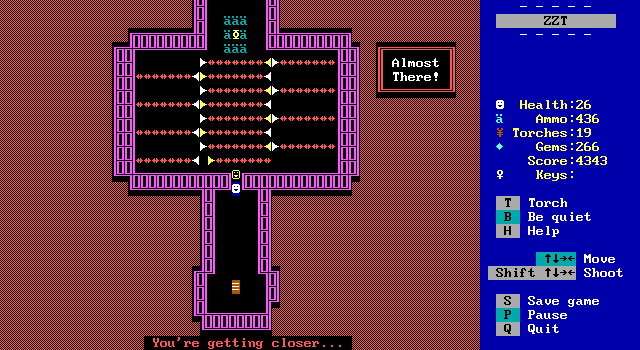
Inside, another guard opens up some more gates.
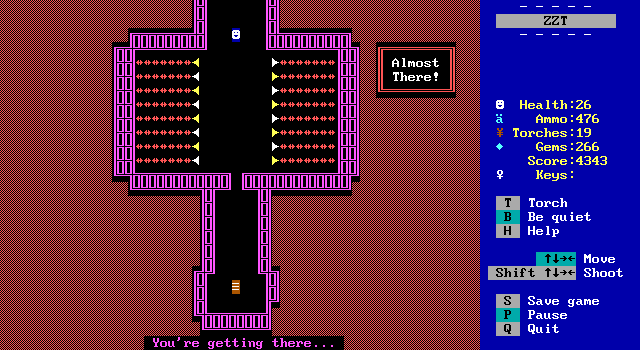
The pattern formed when all it said and done does convey that something grand is going on.
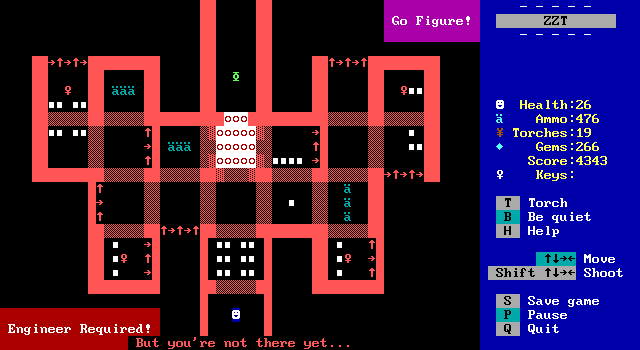
Unsuprisingly, there's still one last puzzle to solve. "Engineer Required!", like "Another Weird Puzzle", is key based and fantastic. This time, the player has to collect just four keys and use them to open up the exit. The challenge comes from the arrangement of spinning guns, all of which are set to the maximum intelligence and firing rate. This means if a player gets even close to them, they will fire nearly non-stop.
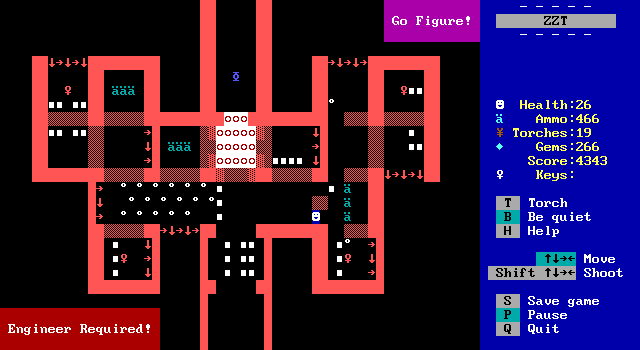
The way to survive, is by carefully positioning boulders in such a way that the guns can't harm the player, slowly making a path to a key while also being able to recover some of the boulders for later use whenever possible.
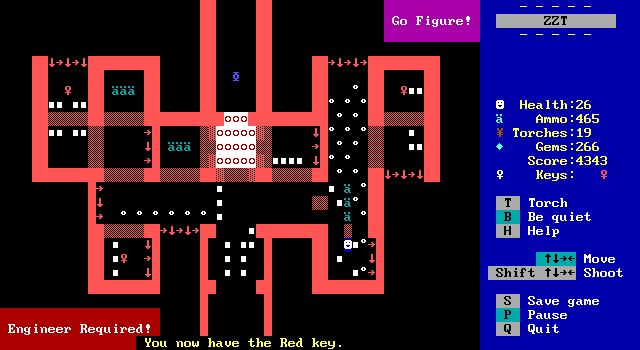
The ammo can be used to block bullets as well, and most likely should be.
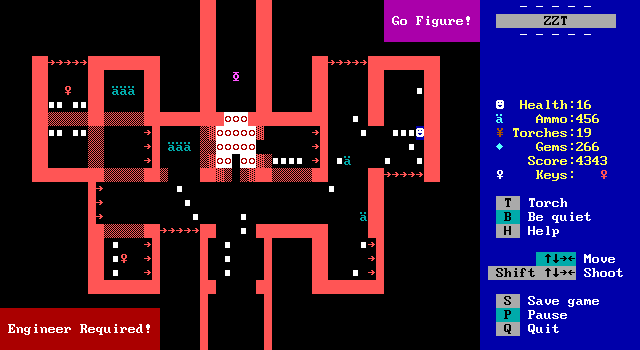
Early on, it's easy to make progress since there are an abundance of boulders not doing anything, but once you start trying to reclaim them, things get difficult.
What makes this puzzle work so well for me, is that it doesn't feel like there's any correct solution. This is the player using the resources they have in the way that suits them best. You can probably come up with several valid routes through the maze. It also excels for being a rare ZZT puzzle where mistakes aren't instantly fatal. You can definitely die on this board, and if you try to move where a gun can shoot, are almost certain to take damage, but any mistakes tend to be noticed after taking a single hit. The more health the player's managed to hold on to, the more reckless they can afford to be, but even walking in here with only two safe hits I felt confident I could think my way through.
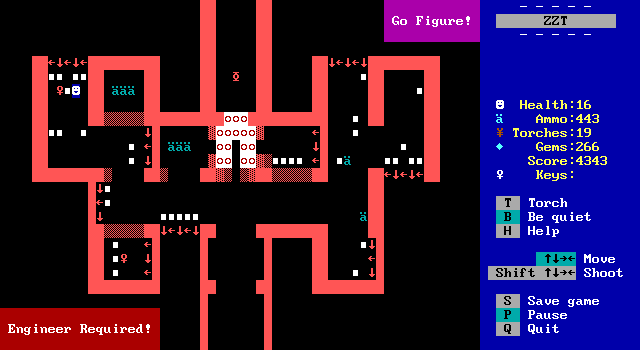
The puzzle even goes so far as to ask that the player use boulders to push away a key in order to be able to pick it up without immediately being shot.
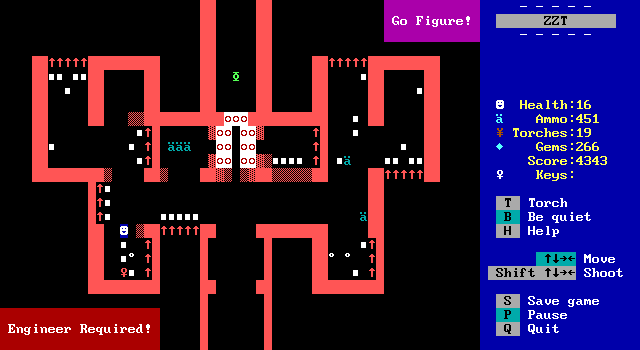
In the end, it's another great puzzle, that has all the challenge of ZZT's most well known, while avoiding the constant need to reload as you realize you've made them unwinnable.
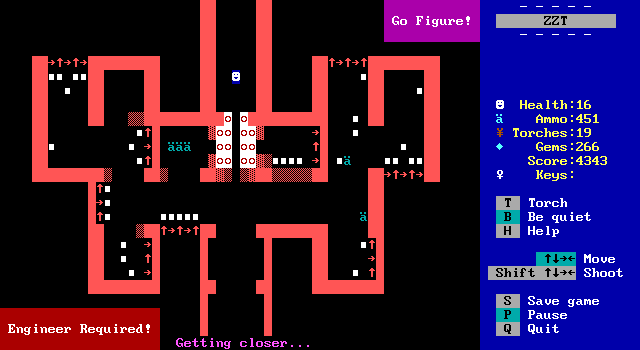
It's just a good job all around.
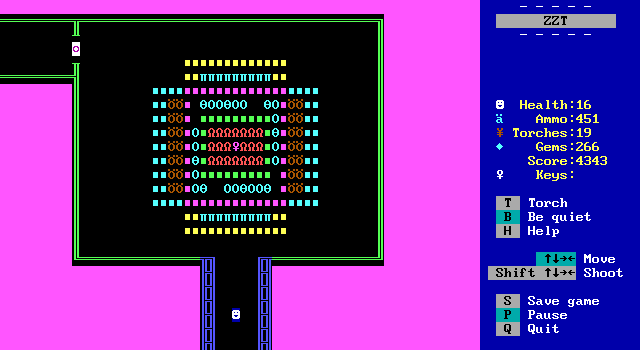
There's one final puzzle/action sequence to go. I've definitely seen this kind of layout used in other ZZT games before, but this would have to be the origin of it. There's a purple key in the center, but collecting it means freeing a bunch of monsters. Some careful movements are necessary to obtain the key.
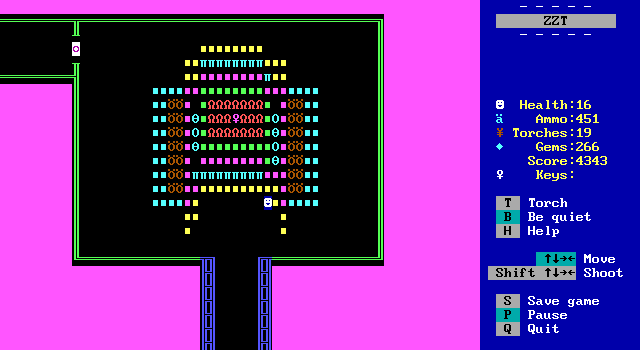
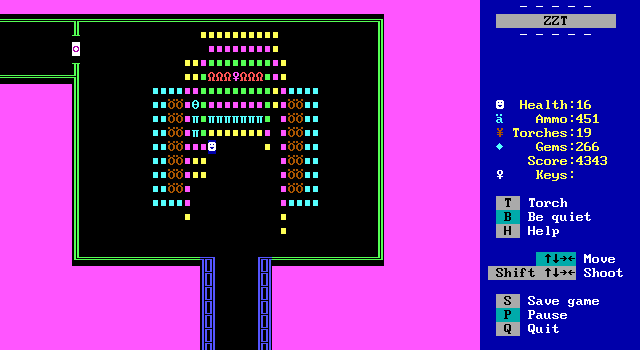
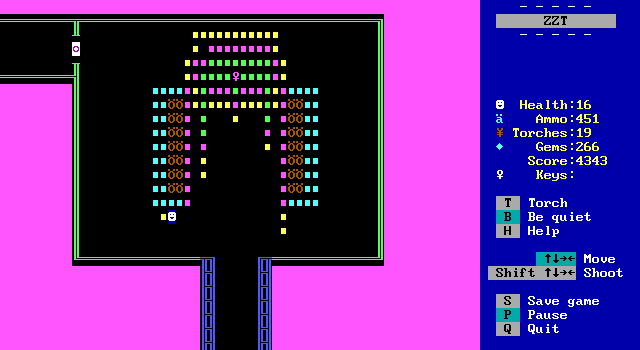
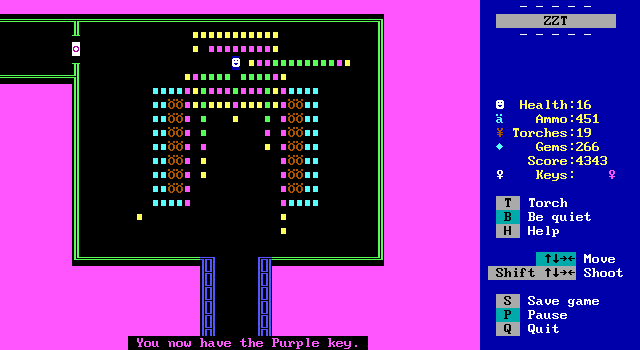
Just kidding. You can very easily just push boulder by boulder and crush the creatures against the wall.
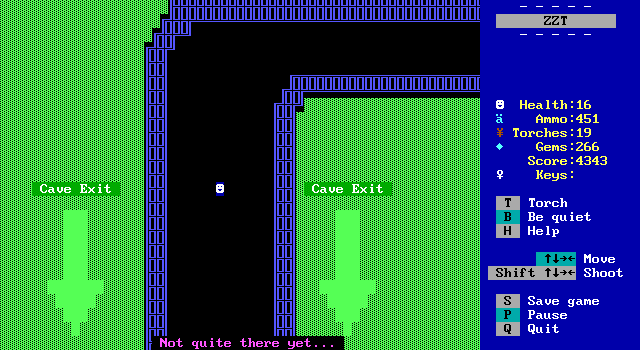
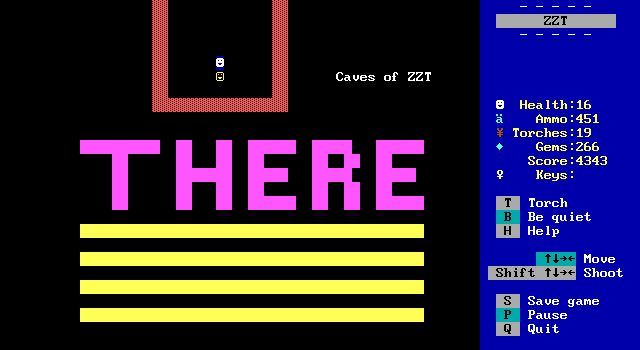
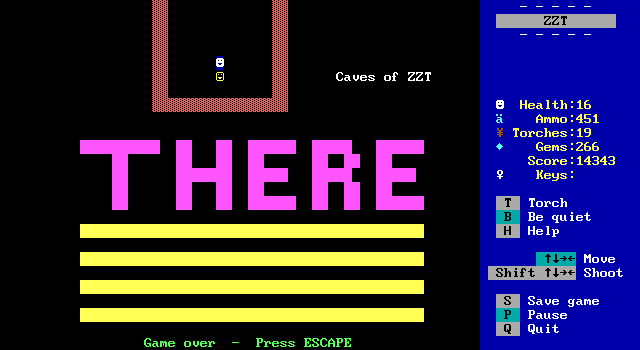
And that's Caves!
Final Thoughts
Caves just really doesn't know what it's trying to do. The other official worlds feel more focused and try to stick to their themes, but Caves feels slapped together in terms of cohesiveness. At the same time though, it offers some excellently constructed puzzles in the form of "Another Weird Puzzle" and "Engineer Required!". The use of built-in enemies is some of the best I've seen, with trickling out enemies via gates, combining bears and conveyors, and that amazing centipede board with the blue keys. When you're on a well constructed board, you know it. Caves offers classic ZZT's best content.
However, while all these boards create a wonderful experience, the boards that don't go above and beyond tend to fall quite short by a large margin. There's a lot of empty space, dull backtracking, and sequences of just shooting a hundred bears for some reason. The game feels like it needed more time to bring some of the weaker boards up to "mediocre", and for that to be a bar that large portions of the game fail to reach is definitely not a good look for the game.
The insistence on darkness doesn't benefit the game either. It's used surprisingly sparingly, making for a a subpar experience during the early portion of the game, though the tiger-ricochet board and transporter puzzle do leverage the unique sort of board design that takes advantage of you not being able to take in the whole board at once. A lot of the dark boards feel like they're less about giving the player a different experience by limiting their visibility, but more like trying to cover up just how bland those boards actually are.
Still, even with the tedium of some of these boards, I think that overall the quality of those which are well made do make Caves worthwhile, just in dire need of some trimming.
In conclusion, Caves of ZZT is a land of contrasts.

